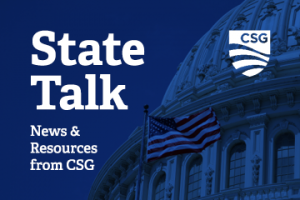
By Ben Reynolds
The Infrastructure Investment and Jobs Act1 — also referred to as the Bipartisan Infrastructure Package — passed the House on Nov. 5. President Joe Biden is expected to sign it today, Monday, Nov. 15. The bill contains $1.2 trillion in funding ($550 billion of which is new spending) for various infrastructure purposes, including roads and bridges, broadband, drinking water resources, airports, electrical vehicles and more. In this brief, analysts at The Council of State Governments break down the $65 billion in funding for broadband expansion and access.
Funding Breakdown
- Establishing the Broadband Equity, Access, and Development Program to be administered by National Telecommunications and Information Administration to states through matching grants – $42.5 billion.
- Investing in and making permanent the Affordable Connectivity Program (formally known as the Emergency Broadband Benefit Program administered by the Federal Communications Commission) to provide a monthly subsidy for low-income families purchasing internet service, with higher subsidies for qualifying families in high-cost areas and households participating in the Women, Infants, and Children (WIC) program – $14.2 billion.
- Investing in the Digital Equity Act Competitive Grant Programs administered by the Department of Commerce – $2.75 billion.
- State Capacity Grant Program for state efforts to achieve digital equity and inclusion.
- Digital Equity Act Competitive Grant Programs (from Competitive Grant Program funds) focused on senior citizens, veterans, minorities and individuals with a language barrier – $250 million.
- Investing in Tribal Broadband Connectivity Program – $2 billion.
- Investing in Middle Mile Grants – National Telecommunications and Information Administration grant program for the construction, improvement or acquisition of infrastructure (prioritizing underserved areas and requiring buildout to be completed within five years of the grant being made) – $1 billion.
Broadband Equity, Access, and Development Program
NTIA will allocate the $42.5 billion of the Broadband Equity, Access, and Development Program three ways:
- Minimum of $100 million funding to each state, with an additional $100 million to be allocated equally among U.S. territories
- Allocates approximately $4.35 billion for broadband projects to underserved locations in high-cost areas. Eligible areas will be determined by NTIA based on a formula defined in the bill (e.g., remoteness, population density, poverty, etc.)
- Approximately $32.2 billion will be allocated for broadband projects in unserved locations.
The Broadband Equity, Access and Development Program is to be established no later than 180 days after the date of enactment of the Infrastructure Investment and Jobs Act. States that wish to participate in the program are to submit a letter of intent, initial proposal and final proposal. Once the NTIA allocates the grants, each state is responsible for submitting a five-year action plan that addresses the areas eligible and the proposed solutions. States can award subgrants to cooperatives, nonprofit organizations, public‐private partnerships, private companies, public or private utilities, public utility districts or local governments.
A matching contribution of at least 25% of the project costs must be provided by a state or its subgrantee. The state match generally has to be from non-federal funds, though some federal sources are explicitly permitted in the bill.
States are required to prioritize unserved service projects until the state can determine universal coverage of all unserved locations. States also must prioritize projects based on additional factors: poverty, speed of proposed services and compliance with federal labor and employment laws.
Sources and Resources
- Summary of Broadband Programs from the Infrastructure Bill from JD Supra.
- Statement from The Council of State Governments on the Bipartisan Infrastructure Package.
- Legislative Analysis for Counties and statement on infrastructure bill passage from the National Association of Counties.
- Statement on infrastructure bill passage from the National League of Cities.
- Breakdown of bill’s contents from CNN and from The Washington Post.
- Estimates of macroeconomic effects of the Infrastructure Invesment and Jobs Act from Moody’s Analytics.
- White House FACT SHEET on the Infrastructure Framework.
- Read the full text of the Infrastructure Investment and Jobs Act here.



